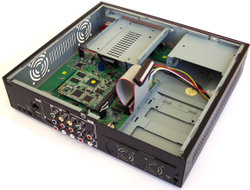Hack the Planet: Neuros' new modder-friendly Linux DVR
DVRs are great, but they tend to be so . . . limited. Whether it's the box you got from your cable company or your own shiny new TiVo, you're still relying on its built-in interface and pre-programmed features.
Of course, you're probably not a coder, so the option of writing your DVR's software from the ground up isn't that big an issue.
If you are a programmer, hacker, or other electronics hobbyist, Neuros might have just the right DVR box for you. The Open Source Device 2 expands upon the original OSD with a plethora of new features and possibilities for the incessant customizer. While the first OSD was intended mostly for the Linux community, it became popular as a simple, inexpensive DVR system for consumers. The OSD2 takes all the appeal of the original OSD (relatively inexpensive, easy to modify, extremely flexible Linux-based operating system), and adds one of the most important features any consumer needs in a DVR: HD video support. Sort of.
The OSD2 can encode 720p MPEG-4 video, and upscale it to 1080i on playback. Okay, you won't be able to rip your Blu-ray discs to 1080p or record your favorite high-def OTA programs at 1080i, but it'll still store some nice HD video. Of course, it's not meant for videophiles, it's meant for the type of people who write software to benefit videophiles.
 Like the OSD, the OSD2 isn't for everyone. Its more of a bare bones DVR development kit than a commercial DVR box. It comes with a port for MorphineTV, a Linux-based TV tuner/HTPC/DVR package, but it practically begs for skilled coders to put their own spin on the system. In fact, last year Neuros and (TiVo upgraders) DVRupgrade issued a $3,500 bounty for hackers who could incorporate or compliment TiVo's features.
Like the OSD, the OSD2 isn't for everyone. Its more of a bare bones DVR development kit than a commercial DVR box. It comes with a port for MorphineTV, a Linux-based TV tuner/HTPC/DVR package, but it practically begs for skilled coders to put their own spin on the system. In fact, last year Neuros and (TiVo upgraders) DVRupgrade issued a $3,500 bounty for hackers who could incorporate or compliment TiVo's features.
Neuros hasn't announced a new bounty for integrating TiVo into the OSD2, but cash prizes are seldom the only reason hackers write their code anyway; you don't climb the mountain for a prize, you climb it because it's there. Or because someone paid you. Or because you want to open a hotel on the peak. Something like that.
The OSD2 includes HDMI, component, composite, and stereo audio outputs, and features USB 10/100 LAN, serial, and IRBlaster ports and a Wi-fi amtenna connector for communicating with the box. It's powered by a Texas Instruments DM6446 "DaVinci" chipset, and includes 256MB of onboard RAM and NAND flash memory. Enough gear to start developing software, but if you want to actually store any video, you're going to need to drop in a hard drive.
The OSD2 is currently available directly from Neuros, and retails for $250. - Will
























































